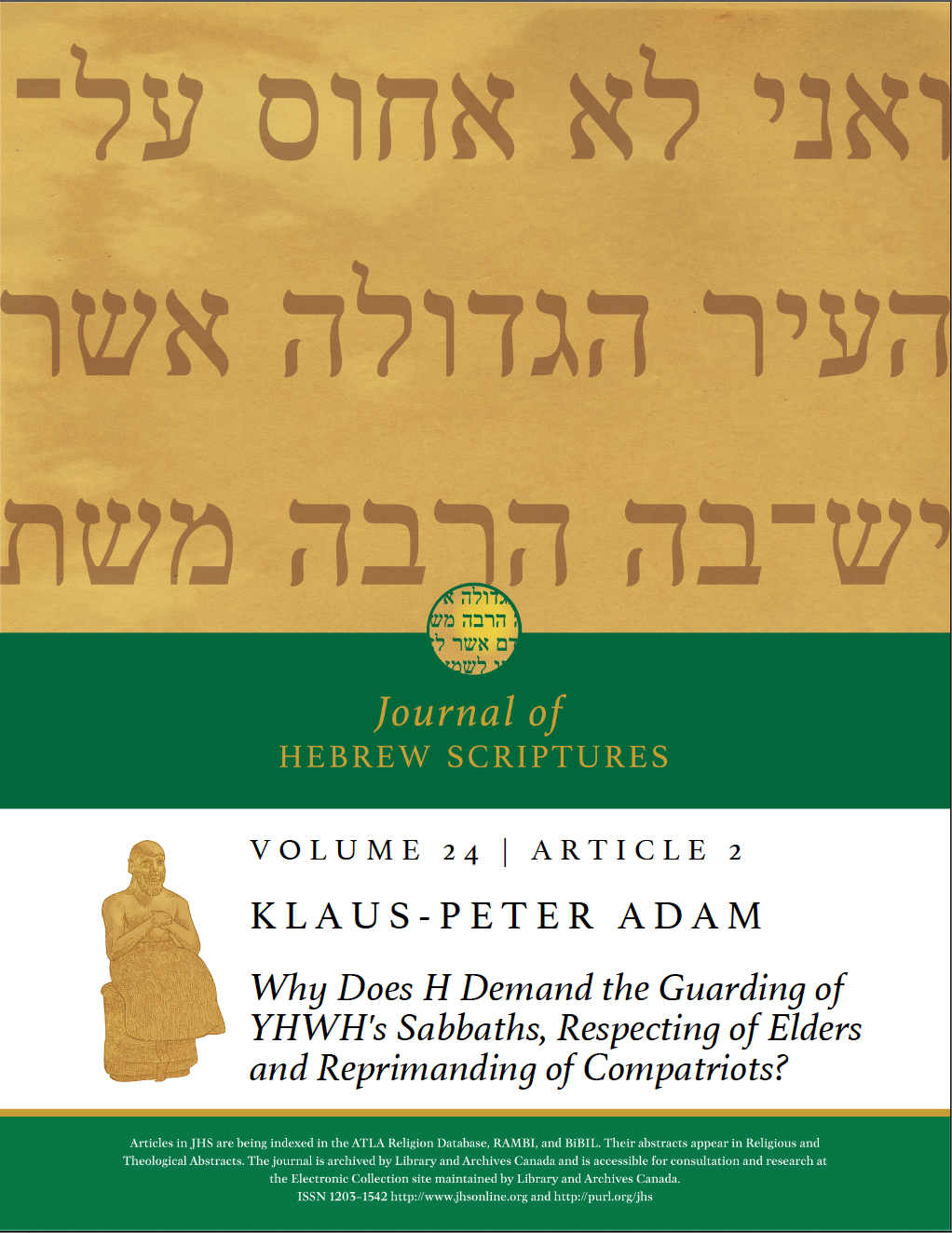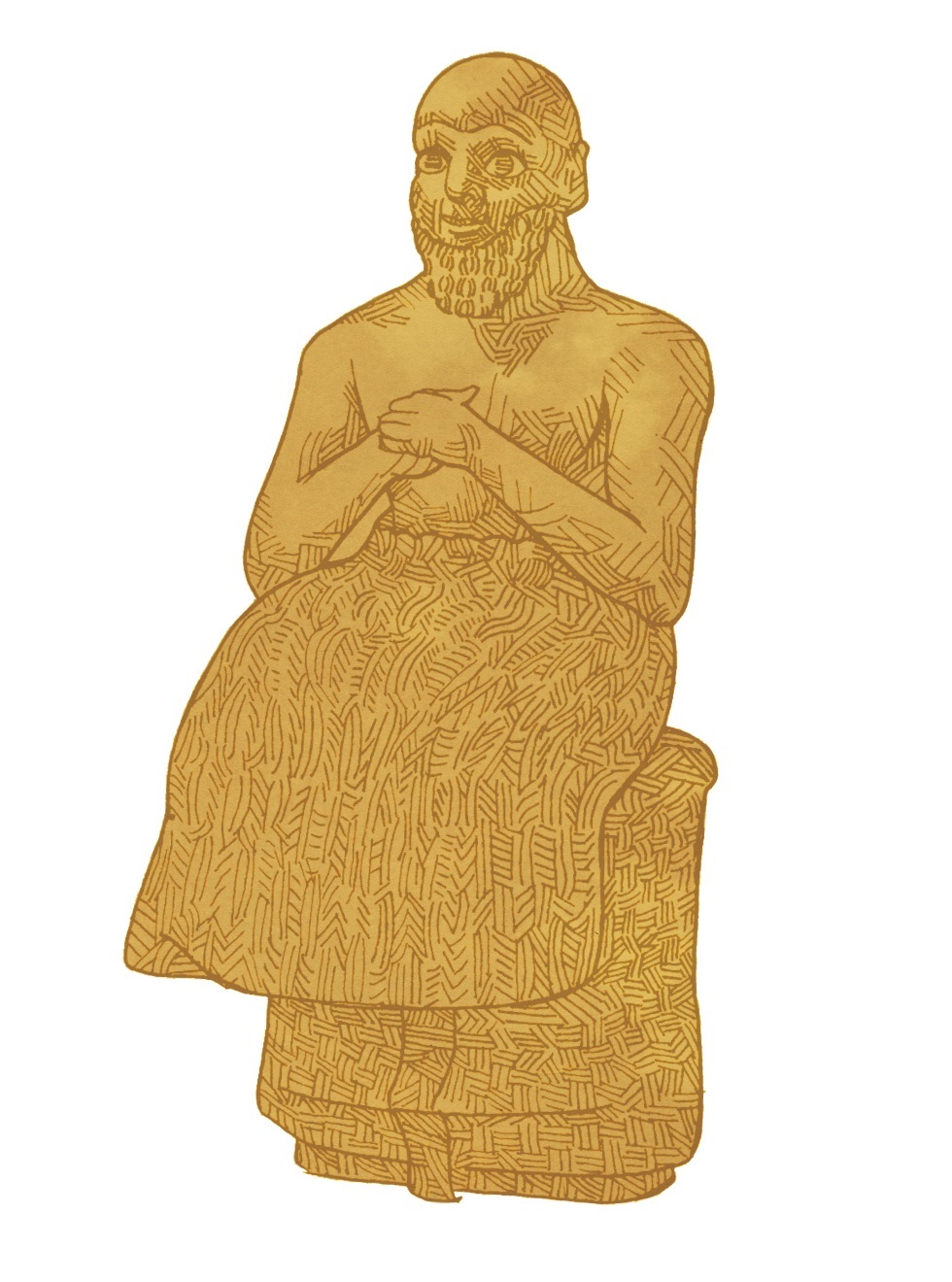Why Does H Demand the Guarding of YHWH’s Sabbaths, Respecting of Elders and Reprimanding of Compatriots?
DOI:
https://doi.org/10.5508/jhs29642Keywords:
Holiness Code, Sabbath, Jurisdiction, Achaemenid YehudAbstract
Among the commands of H, elderly honor, Sabbath observance, and mutual reprimanding of compatriots are hallmarks. The origin, genre, and a comparable legal framework of these sentences can be found in what was labeled rules of (local) religious associations known from demotic papyri, from the Fayum going back to the 6th century BCE. In a tone comparable to a constitutional legislation, H is seen as an analogy for the rules of conflict settlement of local communities: it seeks to keep out governmental authority from local affairs, stipulates the respective festival day, and claims jurisdiction for its local community. All of these are also key elements of H’s anti-Persian stance. Read as a constitutional law of local bulwarks fending off central governmental authority in Egypt, the rules of local religious associations provide a hermeneutical lens for an analogous historical reading of H as "constitutional law." H in Lev 19:3-4, 11-18, 30—as a document of the priestly community in Yehud—would strengthen local institutions, including the arbitrarily stipulated festival day at the sanctuary, the elders as local institution, and internal jurisdiction of a priestly community bolstering itself as a bulwark against transgressions of the Achaemenid empire.
References
Achenbach, Reinhard. Die Vollendung der Tora. Studien zur Redaktionsgeschichte des Numeribuches im Kontext von Hexateuch und Pentateuch. Wiesbaden: Harrassowitz, 2003.
Achenbach, Reinhard. “Numbers,” in The Oxford Encyclopedia of the Books of the Bible, vol. 2. Edited by Michael D. Coogan. Oxford: University Press, 2011.
Adam, Klaus-Peter. Hate and Enmity in Biblical Law. T&T Clark: London 2022.
Agut-Labordère, Damien. “Gods in the Gray Zone: A Political History of Egyptian Temples from Artaxerxes III to the End of the Argeadai (342–ca. 305 BCE).” Pages 177–86 in Times of Transition: Judea in the Early Hellenistic Period. Edited by Sylvie Honigman, Christophe Nihan, and Oded Lipschits. Mosaics: Studies on Ancient Israel 2. University Park: University Press, 2021.
Agut-Labordère, Damien, and Gilles Gorre. “De l’autonomie à l’intégration: Les temples égyptiens face à la couronne des Saïtes aux Ptolémées (Vie-IIIe siècle av. J.-C.).” Topoi 19 (2014): 17–55.
Arlt, Carolin, and Andrew Monson. “Rules of an Egyptian Religious Association from the Early Second Century BCE.” Pages 113-122 in Honi soit qui mal y pense. Studien zum pharaonischen, griechisch-römischen und spätantiken Ägypten zu Ehren von Heinz-Josef Thissen. Edited by Hermann Knuf, Christian Leitz, and Daniel von Recklinghausen. Leuven: Peeters, 2010.
Arnaoutoglou, Ilias. Thusias heneka kai sunousias. Private Religious Associations in Hellenistic Athens. Athens: Academy of Athens, 2003.
Barbiero, Giovanni. L’asino del nemico. Rinuncia alla vendetta e amore del nemico nella legislazione dell’Antico Testamento (Es 23,4–5; Dt 22,1–4, Lv 19,17–18). Rome: Pontificio Istituto Biblico, 1991.
Bardtke, Hans. “Qumrān und seine Probleme.” ThR 33 (1967): 97–119.
Barmash, Pamela. Homicide in the Biblical World. Cambridge: Cambridge University Press, 2005.
Baslez, Marie-Françoise. “Recherches sur le yahad des manuscrits de Qumrân.” Pages 75–92 in Les communautés religieuses dans le monde gréco-romain. Essais de definition. Edited by Nicole Belayche and Simon C. Mimouni. Turnhout: Brepols, 2003.
Blenkinsopp, Joseph. “Did the Second Jerusalemite Temple Possess Land?” Transeuphratène 21 (2001): 61–68.
Blum, Erhard. “Issues and Problems in the Contemporary Debate Regarding the Priestly Writings.” Pages 31–44 in The Strata of the Priestly Writings: Contemporary Debate and Future Directions. Edited by Sarah Shectman and Joel S. Baden. Zürich: Theologischer Verlag, 2009.
Bresciani, Edda. ”Nuovi stati demotici di ‘Confraternite’ dalla necropoli dei Coccodrilli a Tebtynis.” EVO 16 (1994): 49–67.
Briant, Pierre. From Cyrus to Alexander. A History of the Persian Empire. Translated by P. T. Daniels. Winona Lake IN: Eisenbrauns, 2002.
Cannata, Maria. “Three Hundred Years of Dead. The Egyptian Funerary Industry in the Ptolemaic Period.” CHANE 110 (2020): 159–170.
Cenival, Françoise de. Les associations religieuses en Égypte d’après les documents démotiques. Bibliothèque d’étude de l’ Institut Français d’Archéologie Orientale du Caire 46. Cairo: Institut Français d’Archéologie Orientale, 1972.
Cenival, Françoise de. “Papyrus Seymour De Ricci: Le plus ancien des règlements d’association religieuse (4ième siècle av. J.-C.) (Pap. Bibl. Nationale E 241).” REg 39 (1988): 37–46.
Christ, Matthew. The Litigious Athenian. Baltimore: Johns Hopkins, 1998.
Cholewiński, Alfred. Heiligkeitsgesetz und Deuteronomium. Eine vergleichende Studie. Rome: Biblical Institute, 1976.
Cohen, David. Law, Violence, and Community in Classical Athens. Berkeley: University of California, 1995.
Di Bitonto, A. “Le petizioni al re.” Aegyptus 47 (1967): 5–57.
Eckhardt, Benedikt. “Temple Ideology and Hellenistic Private Associations.” DSD 24/3 (2017): 407–23.
Elayi, Josette. Sidon, cité autonome de l’Empire Perse. Paris: Editions Idéaphane, 1989.
Elayi, Josette, Sapin (eds.), Jean. Beyond the River: New Perspectives on Transeuphratene. Sheffield: Academic Press, 1998.
Elliger, Karl. “Heiligkeitsgesetz.” Pages 175–76 in Religion in Geschichte und Gegenwart. Vol. 3. Edited Kurt Galling. Tübingen: Mohr Siebeck, 1959.
Elliger, Karl. Leviticus. Tübingen: Mohr Siebeck, 1966.
Feldman, Liane M. The Story of Sacrifice: Ritual and Narrative in the Priestly Source. Tübingen: Mohr Siebeck, 2020.
Fox, Michael V. “The Sign of the Covenant: Circumcision in the Light of the Priestly ’ôt Etiologies.” Revue Biblique 81 (1974): 557–596.
Fried, Lisbeth S. “A Religious Association in Second Temple Judah? A Comment on Nehemiah 10.” Transeuphratène 30 (2005): 77–96.
Goldenberg, Robert. “Sabbath.” Pages 257–61 in The Oxford Encyclopedia of the Bible and Law. Vol. 2. Edited by Brent Strawn. Oxford: University Press, 2015.
Grünwaldt, Klaus. Das Heiligkeitsgesetz Leviticus 17-26. Ursprüngliche Gestalt, Tradition und Theologie. Berlin: De Gruyter, 1999.
Jacobs, Bruno and Roland Rollinger (eds.). A Companion to the Achaemenid Persian Empire. Blackwell: Hoboken, 2021.
Jones, Nicholas E. The Associations of Classical Athens: The Response to Democracy. Oxford: University Press, 1999.
Joosten, Jan. People and Land in the Holiness Code. An Exegetical Study of the Ideational Framework of the Law in Leviticus 17–26. Leiden: Brill, 1996.
Keel, Othmar: Die Geschichte Jerusalems und die Entstehung des Monotheismus. Teil 2. Göttingen: Vandenhoeck&Ruprecht 2007.
Klawans, Jonathan. Impurity and Sin in Ancient Judaism. Oxford: University Press, 2000.
Klinghardt, Matthias. “The Manual of Discipline in the Light of Statutes of Hellenistic Associations.” Pages 251–70 in Methods of Investigation of The Dead Sea Scrolls and the Khirbet Qumran Site. Present Realities and Future Prospects. Edited by Michael Owen Wise, Norman Golb, John J. Collins, and David G. Pardee. Annals of the New York Academy of Sciences, 722. New York: Academy of Sciences, 1994.
Knohl, Israel. Sanctuary of Silence. The Priestly Torah and the Holiness Code. Minneapolis: Fortress, 1992.
Levine, Baruch A. “The Language of Holiness: Perceptions of the Sacred in the Hebrew Bible.” Pages 241–55 in Backgrounds for the Bible. Edited by Patrick O’Connor and David N. Freedman. Winona Lake, IN: Eisenbrauns, 1987.
Lippert, Sandra. Einführung in die altägyptische Rechtsgeschichte. Berlin: LitVerlag 2008.
Lüddeckens, Erich. “Gottesdienstliche Gemeinschaften im pharaonischen, hellenistischen und christlichen Ägypten.” Zeitschrift für Religions- und Geistesgeschichte 20 (1968): 193–211.
Mathys, Hans-Peter. Liebe Deinen Nächsten wie dich selbst. Untersuchungen zum alttestamentlichen Gebot der Nächstenliebe (Lev 19,18). Fribourg: University Press; Göttingen: Vandenhoeck&Ruprecht, 1986.
McBride, Dean S. “Polity of the Covenant People: The Book of Deuteronomy.” Int 4 (1987): 229–44.
Milgrom, Jacob. Leviticus 1–16. A New Translation with Introduction and Commentary. New York: Doubleday 1991.
Milgrom, Jacob. Leviticus 17–22. A New Translation with Introduction and Commentary. New York: Doubleday, 2000.
Monson, Andrew. “Religious Associations and Temples in Ptolemaic Tebtunis.” Pages 769–80 in Proceedings of the 24th International Congress of Papyrology, Helsinki, 1–7 August, 2004. Vol. 2. Edited by Jakko Frösén, Tiina Purola, and Erja Salmenkivi. Commentationes Humanarum Litterarum, 122. Helsinki: Societas Scientarum Fennica, 2007.
— “The Ethics and Economics of Ptolemaic Religious Associations.” Ancient Society 36 (2006): 221-238.
— “Private Associations in the Ptolemaic Fayyum: The evidence of Demotic accounts.” Pages 178–96 in New Archaeological and Papyrological Research on the Fayyum. Edited by Mario Capasso and Paola Davoli. Lecce: Fabrizio Serra Editore, 2007.
— “42. Rules of an Association of Soknebtunis.” Pages 209–214 in Papyrological Texts in Honor of Roger S. Bagnall. Edited by Rodney Ast, Helene Cuvigny, Todd. M. Hickey, and Julia Lougovay. American Studies in Papyrology, 53. Durham: The American Society of Papyrologists, 2012.
— “Political and Sacred Animals: Religious Associations in Greco-Roman Egypt.” Pages 37–57 in Private associations and Jewish communities in the Hellenistic and Roman cities. The Journal for the study of Judaism Supplement, 191. Edited by Benedikt Eckhardt. Leiden: Brill, 2019.
Muhs, Brian M. “Membership in Private Associations in Ptolemaic Tebtunis.” JESHO 44 (2001): 1–21.
Muhs, Brian M. “Imprisonment, Guarantors, and Release on Bail in the Ptolemaic Fayum.” Pages 89–99 in Le Fayoum. Archéologie-Histoire-Religion. Actes du sixième colloque international Montpellier, 26–28 Octobre 2016. Edited by Marie-Pierre Chauffray, Ivan Guermeur, Sandra Lippert, and Vincent Rondot. Wiesbaden: Harrassowitz, 2018.
Muszyński, Michel. “Les ‘Associations Religieuses’ en Égypte, d’après les sources hiéroglyphyiques, démotiques et grècques.” OLP 8 (1977): 145–74.
Nihan, Christophe. “Heiligkeitsgesetz und Pentateuch. Traditions- und kompositionsgeschichtliche Aspekte von Levitikus 26.” Pages 186–218 in Abschied von der Priesterschrift? Zum Stand der Pentateuchdebatte. Edited by Friedhelm Hartenstein and Konrad Schmid.Leipzig: Evangelische Verlagsanstalt, 2015.
Olyan, Saul M. “Exodus 31:12-17: The Sabbath According to H, or the Sabbath according to P and H?” JBL 124 (2005): 201–9.
Otto, Eckart. “Das Heiligkeitsgesetz Leviticus 17–26 in der Pentateuchredaktion.” Pages 65–80 in Altes Testament. Forschung und Wirkung: Festschrift H. Graf Reventlow. Edited by Peter Mommer and Winfried Thiel. Frankfurt: M. Lang, 1994.
Otto, Eckart. Theologische Ethik des Alten Testaments. Stuttgart: Kohlhammer 1994.
Quack, Joachim F. “Zum Datum der persischen Eroberung Ägyptens unter Kambyses.” JEH 4 (2011): 228–46.
Redon, Bérangère, and Gaëlle Tallet (eds.). “Rencontres, convivialité, mixité, confrontations: Les espaces sociaux de l’Égypte tardive.” Topoi 20 (2016): 11–23.
Rothenbusch, Ralf. Die kasuistische Rechtssammlung im 'Bundesbuch' und ihr literarischer Kontext im Licht altorientalischer Parallelen (Ex 21,2-11.18-22,16) (Münster: Ugarit Verlag, 2000), 229.
Schiffmann, Lawrence. Sectarian Law in the Dead Sea Scrolls: Courts, Testimony, and the Penal Code. Atlanta: Scholars Press, 1983.
Schiffmann, Lawrence. The Eschatological Community of the Dead Sea Scrolls: A Study of the Rule of the Congregation. Atlanta: Scholars Press, 1989.
Schwartz, Baruch. The Holiness Legislation. Jerusalem: Magnes Press, 1999.
Schwartz, Baruch. “Israel’s Holiness. The Torah Traditions.” Pages 47–59 in Purity and Holiness. The Heritage of Leviticus. Edited by Marcel Poorthuis and Joshua J. Schwartz. Leiden: Brill, 2000.
Schwartz, Baruch. “Leviticus, Commentary.” Pages 193-266 in The Jewish Study Bible, 2nd edition. Edited by Adele Berlin and Marc Zvi Brettler. Oxford: Oxford University Press, 2014.
Stackert, Jeffrey. “Holiness Code and Writings.” Pages 388–96 in The Oxford Encyclopedia of the Bible and Law. Edited by Brent Strawn. Oxford: University Press, 2015.
Stackert, Jeffrey. “Compositional Strata in the Priestly Sabbath: Exodus 31:12-17 and 35:1-3.” JHS 11 (2012): 1–20.
Steinhauer-Hogg, Julietta. Religious Associations in the Post-classical Polis. Stuttgart: Franz Steiner, 2014.
Sternberg-el-Hotabi, Heike. “Die persische Herrschaft in Ägypten.” Pages 111–49 in Religion, Religionskontakte im Zeitalter der Achämeniden. Edited by Reinhard Gregor Kratz. Gütersloh: Chr. Kaiser, 2002.
Strawn, Brent. “Intention.” Pages 433–46 in The Encyclopedia of the Bible and Law. Edited by Brent Strawn. Oxford: University Press, 2015.
Vittmann, Günter. “Eine Urkunde mit den Satzungen eines Kultvereins (P. dem. Mainz 10).” Pages 169-179 in Von Theben nach Giza. Festmiszellen für Stefan Grunert zum 65. Geburtstag. Edited by Frank Feder, Ludwig D. Morenz, and Günter Vittmann. Göttingen: Hubert&Co: 2011.
Weinfeld, Moshe. The Organizational Pattern and the Penal Code of the Qumran Sect: A Comparison with Guilds and Religious Associations of the Hellenistic-Roman Period. Fribourg: University Press; Göttingen, Vandenhoeck&Ruprecht, 1986.
Zobel, Hans-Joachim. “עמית.” Pages 192–96 in Theological Dictionary of the Old Testament. Vol. 11. Edited by G. Johannes Botterweck, Helmer Ringgren, and Heinz-Josef Fabry. Grand Rapids: Eerdmans 2001.

Downloads
Published
How to Cite
Issue
Section
License
Copyright (c) 2024 Klaus-Peter Adam

This work is licensed under a Creative Commons Attribution 4.0 International License.

 Statue of Ebih-Il, drawing by Simeon Goa, © Journal of Hebrew Scriptures
Statue of Ebih-Il, drawing by Simeon Goa, © Journal of Hebrew Scriptures
